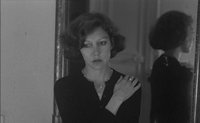Faceted, fragmented, and oneiric, Philippe Garrel’s Elle a passé tant d’heures sous les sunlights… (She Spent So Many Hours Under the Sun Lamps) is more exorcism than expurgation, elegy than lamentation – an abstract, yet lucid chronicle of love and loss, death and birth sublimated through textural, self-reflexive impressions, visceral gestures, and metaphoric tableaux. A profoundly personal film dedicated to the memory of friend and fellow filmmaker (and May 68 idealist) Jean Eustache, and haunted by the unreconciled specter of Garrel’s failed relationship with Nico, the film opens to a crepuscular image of a couple – perhaps an actor and his lover (Jacques Bonnaffé and Anne Wiazemsky) as apparent surrogates for Garrel and Nico – in the midst of a breakup on a public street on a cold, winter evening, as their seemingly tenuous reconciliation is truncated by the subsequent shot of the couple returning home, and an all too familiar rupture as she once again lapses into the desensitized haze of heroin addiction in the distraction of his preoccupying rehearsals. A seemingly isolated shot of another woman, an actress named Marie (Mireille Perrier) waiting in the office of the Ministry of Art subsequently connects the troubled couple through the sound of the rapid, half-whisper, off-screen script reading, first by the actor preparing for the role in the apartment, then subsequently by the voice of the filmmaker, Philippe (Philippe Garrel) as he casts her in his latest project – the seemingly disparate narrative arcs reconciled through the intersection of the autobiographical nature of Philippe’s proposed project inspired by his own tumultuous relationship with model, singer, actress, and muse Nico (a transparency between art and life that is further compounded by the eventual appearance of Garrel as the director of the “film within a film” film). Another break in logic is created in the long shot of the actor, in the role of the film director, discarding a film reel from a bridge overlooking the river before meeting Marie, initially unfolding as the shooting of a film scene through the transformation of Marie’s visage at the moment of performance, but subsequently subverted by the repeated episode of the couple – perhaps no longer acting in character – driving away, a romantic liaison that is reinforced by a subsequent, silent image of the couple engaged in an (apparently) intimate conversation.
Gradually, the bounds between reality and fiction begin to disintegrate in the interpenetration of dreams and memories, passions and anxieties, becoming increasingly fractured and irresolvable. Like his alter-ego character on the bridge, Philippe has grown apprehensive over the seeming irresolution of the film, and enlists the aid of friends: Chantal Akerman who is, uncoincidentally in the process of shooting The Eighties, a metafilm on the nature of repetition and performance); Christa, also played by Wiazemsky, and who, in turn, also evokes a self-reflexive, permeable reality through reconstructed, iconic poses that not only allude to Nico’s early career as a fashion model, but also mimic the Bressonian model figuration of her character, Marie in Robert Bresson’s Au Hasard Balthazar); and actor Lou Castel, whose “new” character is introduced midway through the film shoot as Marie’s new paramour (and indirectly, replacing Philippe – through his alter-ego – from her life). It is interesting to note that in introducing Castel into the film, Philippe not only enables a means of closure for his failed relationship with his former lover through their surrogate selves, but also illustrates the emotional process of transference, transition, and figurative rebirth. In essence, the transfiguration of death – subliminally illustrated, initially, through the liberating image of Marie riding carefree in an automobile to the music of Nico that serves as an evocative counterpoint to Jean Eustache’s debilitation from a car accident, then subsequently, through the shot of a somber Garrel standing beside a collapsed noose that alludes to Eustache’s suicide – inevitably paves the way for the film’s second chapter (and metaphoric turning point), La Nativité. Inspired by the birth of his son, Louis (and who would later appear Emergency Kisses and Regular Lovers), the film dissolves into an instinctual collage of quotidian portraitures – of actors waiting, pacing, observing – of temps morts. Concluding with the elliptical, parting shot of Philippe standing by a window in visible discomfort as evening approaches, his suffering becomes as a double entendred, metaphoric representation: the physical withdrawal (whether through substance abuse or the separation of death) of profound loss, and the implacable – but necessary – ache of realized creation.
© Acquarello 2006. All rights reserved.
